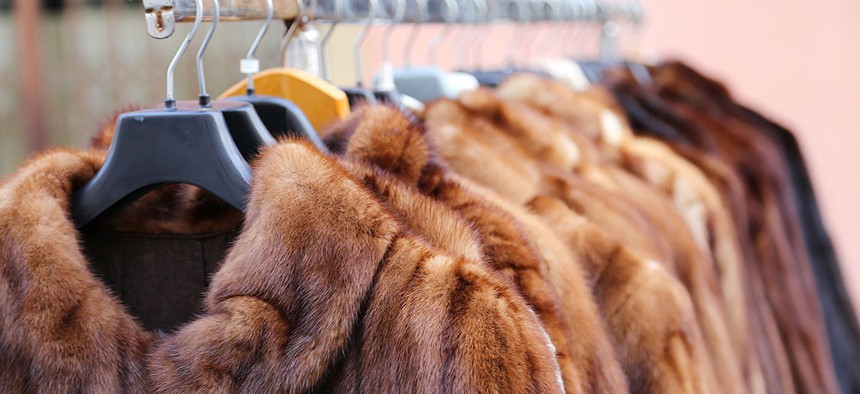New York City
Banning fur is bad for New York
The City Council’s proposed ban on the sale of fur throughout the five boroughs should give pause to anyone who cares about jobs and being able to choose what they want to purchase, writes Karen Giberson, president of the Accessories Council.

A clothing rack full of fur coats. ChiccoDodiFC/Shutterstock
The New York City Council’s proposed ban on the sale of fur throughout the five boroughs should give pause to anyone who cares about jobs and being able to choose what they want to purchase, wear or even eat. As the head of the Accessories Council, representing hundreds of fashion designers and brands in New York and across the country, this law would be a major blow to our industry, our creative freedom and our employees.
The bill, which says it would prohibit “the sale of fur apparel,” is very misleading, as it covers other materials as shearling and calf-hair leather, which are not traditionally classified or recognized as “fur.” In addition, the term “apparel” is defined as any clothing or accessory using these materials in full or in part. Hence, the proposed law goes far beyond its title in materials and category reach.
A ban on any of these products, however, is unacceptable. The bill, which was just introduced in late March, is being inexplicably fast tracked to the hearing stage, which has been scheduled for May 15. This does not allow our industry ample time to prepare or accurately study the implications of this decision. We are baffled as to why there is a sudden rush to pass this legislation.
If government can pick and choose to eliminate a specific material, then what’s to stop politicians from telling us what else we can’t wear, eat and create moving forward? As the fashion capital of the world, we must work with textiles and fabrics that our customers are demanding today. Our industry has embraced a variety of materials, including vegan leathers, faux furs and other options that are being developed every day. That said, calf hair, shearling and fur still play a significant and sustainable role in our designs – from shoes, handbags, gloves and hats, to trim and cuffs on coats.
Fur is already a heavily regulated industry, with rules covering from farming and trapping standards to ethics to labeling. The animal byproducts are used in a variety of other products, from the beauty industry to compost and fertilizers. We encourage all to learn more about the process. If you don’t like these materials, you don’t need to use them, to manufacture with them or buy them as a consumer.
New York City is the hub of retail, wholesale, trade shows and commerce for many fashion accessory companies. The ban preventing any sale of these products would cut off one of designers’ largest markets, negatively impacting their livelihoods and those of the suppliers and retail shops they work with. In all, a recent economic study commissioned by the International Fur Federation Americas found the ban would result in $850 million in lost taxable business revenue and cost New York City 7,500 jobs in the first year alone.
According to a survey we conducted this month of accessory and outerwear companies in Manhattan’s Garment District, more than 90 of the factories there use these materials, making items such as gloves, handbags and outerwear. One of them, Cockpit USA, makes shearling coats for the United States military. These are specialized experts. If the “fur ban” passes, some of them would need to close their businesses, while others would face significant layoffs.
Let’s be realistic: If the law passes and a manufacturer can’t sell in New York City, the owner has two choices: close up the business and fire all employees or lay off workers and rent space in New Jersey, Yonkers or Nassau County to ship the product. Either way, once again New York City loses much-needed manufacturing jobs – but this time it’s by its own direct action.
Losing valuable blue-collar jobs is not the only unintended consequence of this legislation. Council members have championed environmental issues. In this case, they fail to recognize the negative environmental impacts of synthetic materials. Most fake furs are petroleum-based and do not biodegrade. One faux fur coat is the equivalent of thousands of plastic straws.
My biggest concern, however, is that a fur ban would be just the start. Animal rights activists have made no secret of the fact that their eventual goal is to ban the use of all animal products. If the City Council succeeds in banning fur today, they will next take aim at leather, feathers, wool and silk.
To wear fur, like any consumer product, is a choice. It’s one New Yorkers have been making for hundreds of years and a product that remains in high demand today. It’s not the job of City Council members to legislate away livelihoods simply because fur is a choice some of them wouldn’t make for themselves.
Correction: Due to a misplaced comma, this article incorrectly implied that the proposed legislation would ban leather, not just cow-hair leather.
NEXT STORY: Fashion is thriving without fur

